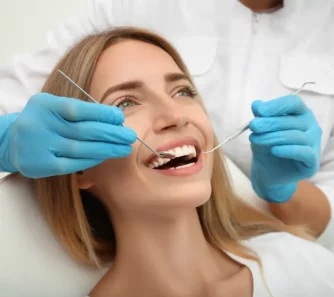Inlays and Onlays
Inlays and Onlays are partial crowns that can be made of porcelain. They are recommended for large cavities or replacement of large old metal (mercury) fillings that are not restorable with regular filling materials. Impression of the prepared tooth is sent to the laboratory for the ceramist to handcraft the restoration. This procedure will take two appointments. Advantage of Inlays/Onlays are the conservation of healthy tooth structures.
Indirect Composites
Crowns, inlays and onlays can be made in the laboratory from dental composites. These materials are similar to those used in direct fillings and are tooth colored. One advantage to indirect composites is that they do not excessively wear opposing teeth. Their strength and durability are as high as porcelain or metal restorations and they are less prone to wear and discoloration.
How is this procedure performed?
Inlays and onlays are performed using very similar procedures. Both require two trips to the dental office. At the first appointment, Dr. Nader Ahdout begins the procedure by numbing the area using a local anesthetic. The decay or damage is removed using a drill, preparing the tooth for its new surface. After all the damage is removed, an impression is made of the prepared tooth so the inlay or onlay material can be cast in a form that will fit the tooth exactly. A temporary restoration is placed on the tooth to protect it for two to three weeks until the laboratory makes the new structure and it can be bonded to the tooth.
Using the impression, a laboratory prepares the new tooth surface using gold, porcelain or composite resin. Upon return to the dentist’s office, the temporary restoration is removed and the surface is cleaned to prepare for the new structure. Dr. Nader Ahdout will then try in the new restoration to ensure that there is a correct fit that doesn’t interfere with your bite. If the fit is good, using special cement or bonding, the inlay or onlay is permanently attached to the tooth. Some minor adjustment may need to be made to the restoration if there are interferences.
What are the most common benefits of this procedure?
Inlays and onlays are ways of repairing relatively extensive tooth decay or damage without having to replace the whole outer portion of the tooth as with a crown. Less tooth material is removed so inlays and onlays tend to be more conservative and esthetic than crowns. Unlike fillings, these procedures strengthen a tooth’s structure. They also tend to last longer than a filling, because the inlay or onlay material is custom made and bonded to the tooth.
In a situation where there is not enough remaining solid tooth structure after decay and fragile tooth structure is removed, or the tooth has fractured and is now missing important architectural reinforcements, the tooth might very well require an extracoronal restoration: a restoration consisting of a dental material that will exist around the remaining tooth structure to a varying degree. Restorations that fall into this category include the various types of crowns and onlays, and these can consist of a number of materials as well, including gold, ceramic, or a combination of the two. Ceramic crowns are increasingly being substituted in place of gold crowns for aesthetic and structural reasons. In a recent study, only 1.7% of the ceramic crowns needed to be replaced after 2 years, with 3.7% showing occlusal chipping without need of replacement.
The circumstance of the damaged tooth defines the restoration. In other words, based upon factors such as remaining solid tooth structure, aesthetics, the location of the tooth within the dental arch and the consequent forces of function that said tooth will have to deal with once restored, Dr. Nader Ahdout will then decide on the proper way to treat the tooth.
Things are not always straightforward when it comes to restoring a tooth. An advantage of crowning a tooth over restoring the tooth with an excessively large pin-supported amalgam or composite restoration is that crowns provide much more protection against future fracture or recurrent decay. The indirect techniques of crown fabrication translate into a more adapted tooth-restoration margin, and thus a better seal against the decay-causing bacteria present in saliva.
Service Is Our #1 Priority.

General Dentistry
Our experienced team is pleased to provide a full spectrum of general dentistry services, from simple checkups and cleanings all the way through complex treatments such as dental implants, crowns, bridges, root canals and extractions.

Emergency Dentist
Our team at Smiles Creator understands the immediacy these situations demand, and we're prepared to offer exceptional dental services to assist you.

Dental Implants
Our dental implant services are comprehensive, covering every stage of the process from initial consultation to final placement and aftercare.

Cosmetic Dentist
In the realm of cosmetic dentistry, which merges artistic flair with scientific precision, our focus is on elevating the look and health of your teeth and smile.

Sedation Dentistry
This is achieved by using sedatives during procedures to create a comfortable and anxiety-free experience.

Dental Spa
Our facility is a unique fusion of top-notch dental services and the tranquility of a spa, setting a new standard in dental care.
